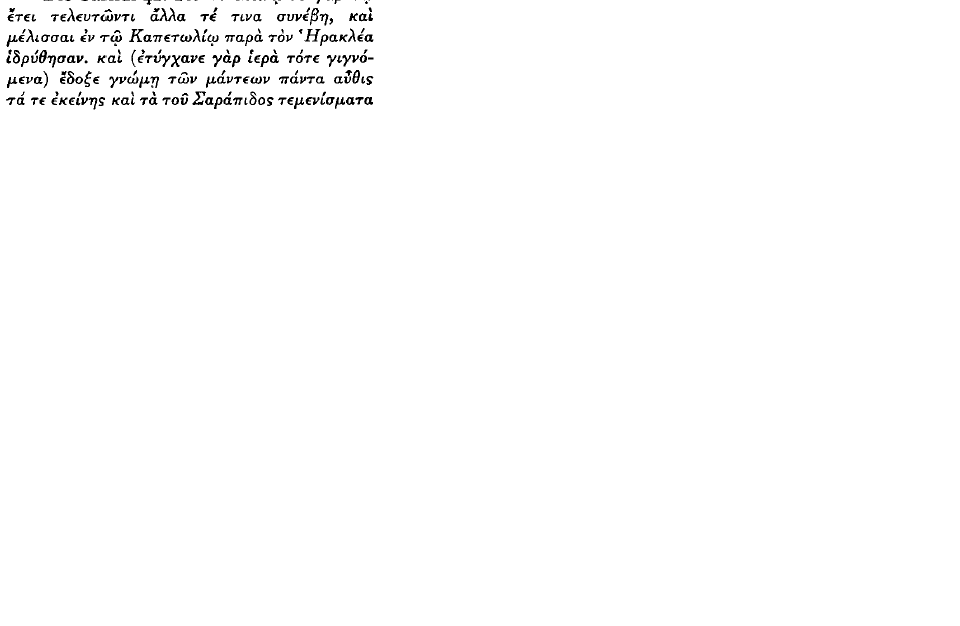Article contents
Three Historical Puzzles in Histories 3
Published online by Cambridge University Press: 11 February 2009
Extract
The present paper proposes to discuss three passages in Tacitus, Histories 3 where current interpretations have led to difficulties which can be shown to be baseless so soon as it is realized that Tacitus is willing on occasion to sacrifice truth and clarity to stylistic effect. In each of these passages the same literary device lies at the root of the matter, a device which (for want of a better term) may be labelled ‘die grouping of participles’: the juxtaposition of participles in a sentence to die detriment of strict chronological order.
- Type
- Articles
- Information
- Copyright
- Copyright © The Classical Association 1956
References
page 208 note 1 3. 21. 1; 15. 2; 18. 1.
page 208 note 2 ‘Die zwei Schlachten von Betriacum im J. 69’, Hermes, v (1871), 161–73;Google Scholar cf. also Holzapfel, , Klio, xv (1918), 116, n. 3.Google Scholar
page 208 note 3 Ibid. 169, n. 5.
page 208 note 4 Nischer, , ‘Die Schlacht bei Cremona’, Klio, xx (1926), 187–201,Google Scholar esp. 192 and n. (his reconstruction of the second battle of Bedriacum is, however, mistaken); Dessau, , Gesch. d. röm. Kaiserzeit, 2. 1. 357 n., 358, n. 4 (the plausibility of whose views cannot here be argued). By way of contrast, I quote the unhappy remark of M. Bassols de Climent (edition, Madrid-Barcelona, 1951): ‘Setrata de un puente tendido sobre el rio Tartaro, que permitia la comunicación de las tropas … con el sur de Italia.’Google Scholar
page 209 note 1 No. 63 (Legnano).
page 209 note 2 For the Valli Grandi Veronesi see Encicl. ital. xxxiv. 936 f.Google Scholar
page 210 note 1 For the tense of flexit see Sörbom, , Variatio sermonis Tacitei, pp. 100 f.Google Scholar
page 210 note 2 A less colourful reason for delay may be found in Valens‘ concern at not receiving from Caecina as arranged (H. 2. 100. 2) his own troops, legio v Alaudae and vexillations of I, xv, and xvi.
page 210 note 3 It is not necessarily illogical (as Hardy, , J. Phil. xxxi [1910], 148 claims) to use praemittit of a man who did not intend to follow his van to Ariminum; for as far as Meuania he may in fact have travelled in the train of the cohorts if the latter were sent ahead from Falerii, as is quite possible; or the verb may reflect Valens' ostensible rather than his real intentions.Google Scholar
page 212 note 1 The demolition of private shrines of Isis had already begun in 59 B.C., if we accept Ziehen's ingenious restoration of a phrase in Cicero, ad Att. 2. 17. 2, as ut prae hoc Isis Curiana stare uideatur (Hermes xxxiii [1898], 341Google Scholar and cf. Seeck, ibid, xliii [1908], 642 f.).
page 212 note 2 Dio Cassius 42. 26. 


page 212 note 3 For the disfavour with which the worship of Isis was viewed officially in the period from Sulla to Vespasian see Preller, , Römische Mythologie 2, pp. 727 ff.,Google Scholar P.-W. s.v. ‘Isis’, coll. 2103–4 (Roeder), and Nock, A. D., Conversion, pp. 74–75, 124 ff.Google Scholar Lucan 8. 831 refers to the temple of Isis Campensis, and there is nothing in Suet. Otho 12. 1 to connect Otho's singular devotion to Isis wim the Capitol.
page 213 note 1 For this date I follow the careful reason ing of Holzapfel, L., ‘RömischeKaiserdaten3,’ Klio xiii (1913), 295 ff.,Google Scholar rather than the view of Weynand (P.-W. s.v. ‘Flavius’, coll. 2544, 2624, and 2640) and others (e.g. Charlesworth, in C.A.H. xi. 4)Google Scholar, who assign the death of Vitellius to 21 December.
page 213 note 2 The disguise was not novel. In 43 B.C. the aedile Marcus Volusius escaped the proscriptions by putting on the long linen surplice and the black dog's head mask of Anubis, furnished by a friend who was a priest of Isis (Appian, , B.C. 4. 47Google Scholar). So also the Capitoline hiding-place had been antici-pated by Piso Licinianus (Tac. H. 1. 43Google Scholar), who took refuge, but ineffectually, in the contubernium of the Temple of Vesta in the forum Romanum. Here the attendant's house must have formed part of the sacred building itself, but on the Capitol, where the temple-area was extensive, it may have lain some little distance from the aedes, since it was not burnt with it, but was later pulled down by Domitian to provide a site for his Jupiter shrine.
page 213 note 3 Where he might well consider himself in sinu dei (74. I, quoted below).
page 214 note 1 Games: see Lana, Italo, ‘I Ludi Capito-lini di Domiziano’ in R.I.F.C., N.s. xxix (1951). 145–60.Google Scholar
page 214 note 2 Statius, Theb. 1. 21 defensa prius uix pubescentibus amis Bella Iouis; Silu. 1. 1. 79–81 tu bella Iouis … Marte domas; Martial, Ep. 9. 101. 14 prima suo gessit pro hue bella puer (Domitian, born 24 October 51, was now 18 years old); Josephus, , B.I. iv. 11. 4 
 Tac. H. 2. 101. 1.Google Scholar
Tac. H. 2. 101. 1.Google Scholar
- 2
- Cited by




